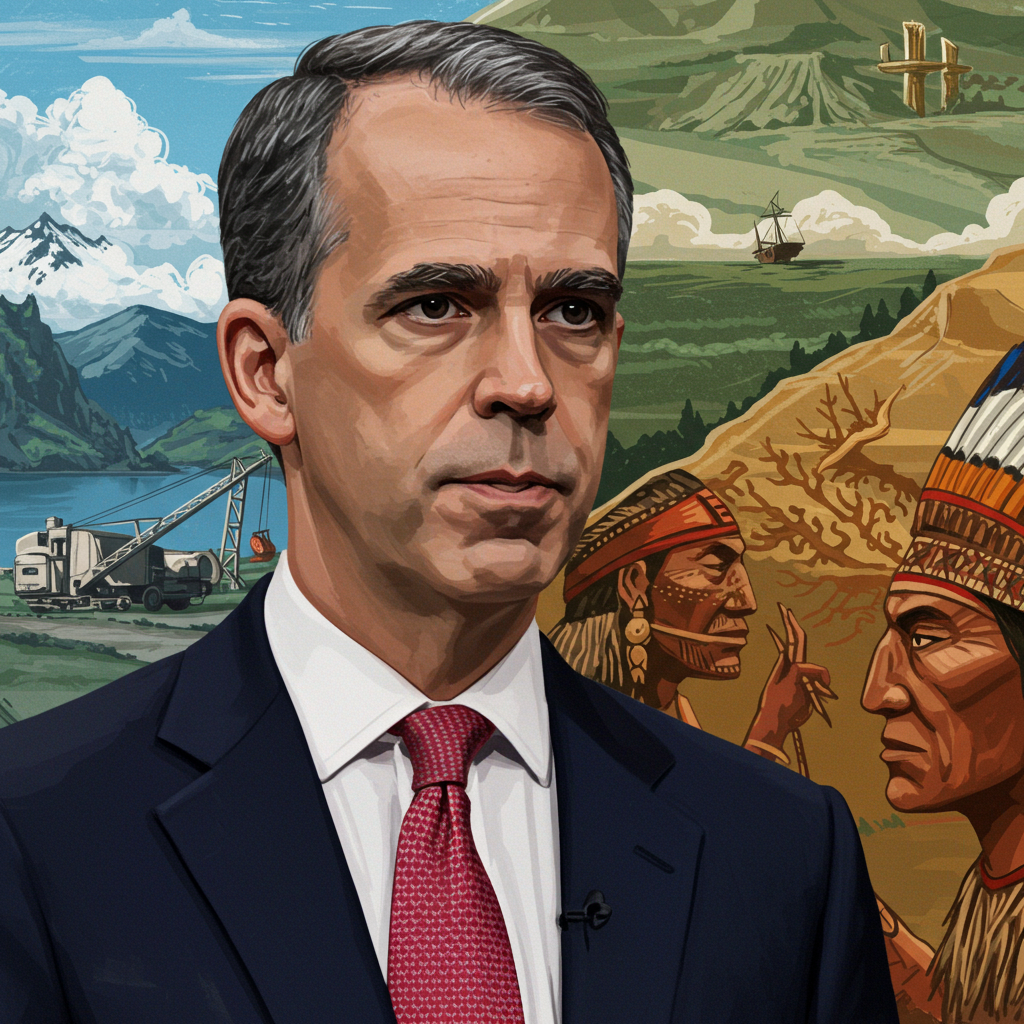Canada’s ambitious push for rapid national development under Prime Minister Mark Carney faces significant hurdles. His administration’s call to “Build, baby, build” aims to reshape the economy through major infrastructure and energy projects, reducing reliance on the United States and boosting trade globally. However, these grand plans inevitably intersect with the rights and lands of indigenous Peoples. Unlike past eras where Indigenous voices were marginalized, leaders across the country are now demanding a fundamental shift: a genuine say, and potentially veto power, over projects impacting their territories. This tension highlights the complex challenge of balancing economic aspirations with the imperative of reconciliation and inherent Indigenous rights in Canada.
The “Build, Baby, Build” Vision
Prime Minister Carney champions a vision of a “Canada strong,” emphasizing national interest projects to revitalize the economy. This includes a wide array of potential developments, from oil and gas pipelines and nuclear facilities to mines, power grids, ports, roads, and railways. The core motivation stems partly from a desire for greater economic independence and diversification, particularly in response to increasing trade tensions and tariffs from the United States. The goal is to expedite these large-scale undertakings, positioning Canada as a more self-reliant “energy superpower” capable of exporting resources like liquefied natural gas (LNG) to global markets beyond its southern neighbour.
The recent operational startup and first export from the LNG Canada facility in British Columbia, a massive multi-billion dollar project, symbolizes this push. It represents a significant step towards sending Canadian natural gas to Asia, diversifying away from the current near-total reliance on the U.S. market for gas exports. Industry leaders support this direction, seeing Canada’s potential as a major global energy player. However, achieving this vision requires substantial infrastructure, and Canada has historically struggled to build the necessary export capacity, leaving much of its resources discounted due to limited market access.
Indigenous Rights at the Forefront
Historically, major development projects in Canada were often pursued with little regard for Indigenous Peoples’ rights or connection to their ancestral lands. This approach led to dispossession, environmental damage, and lasting negative impacts. In the current era of reconciliation, Indigenous leaders insist things must change. They emphasize that any nation-building effort cannot proceed by ignoring the foundational rights of First Nations, Inuit, and Métis communities.
“It’s up to governments to come and see us about decisions concerning our territory,” states Dave Petiquay, a traditional leader of the Atikamekw First Nations people in Wemotaci, Quebec. He highlights a common frustration: governments often make decisions and pass laws before engaging with communities, rather than involving them from the outset. Indigenous groups assert their inherent sovereignty and their right to determine what happens on their lands and waters.
This demand for control goes beyond simple consultation. It requires a fundamental shift in power dynamics, seeking active participation and, crucially, the right to withhold consent.
The Legal Framework: Consultation to Consent
Canada’s legal landscape governing the relationship between the Crown and Indigenous Peoples is complex and evolving. Section 35 of the Constitution Act, 1982, affirms existing Aboriginal and treaty rights. Supreme Court rulings have further established the Crown’s duty to consult and, where appropriate, accommodate Indigenous communities when potential or established rights might be adversely affected by proposed projects. The depth of consultation required depends on the strength of the rights claim and the severity of the potential impact.
Adding another layer is the 2021 federal legislation aimed at implementing the United Nations Declaration on the Rights of Indigenous Peoples (UNDRIP). UNDRIP emphasizes the principle of Free, Prior, and Informed Consent (FPIC). This means that Indigenous Peoples have the right to give or withhold consent for projects affecting their lands, territories, or resources. While the legal interpretation of FPIC within Canadian law, particularly its distinction from the duty to consult and whether it constitutes a “veto,” is still a subject of debate and potential court challenges, Indigenous leaders view it as a non-negotiable standard for meaningful engagement.
Many Indigenous leaders criticize past and present consultation processes as merely “box-checking exercises” designed to fulfill a legal minimum rather than achieve genuine agreement. They point to historical and ongoing disputes, such as conflicts over pipelines where traditional hereditary leaders opposed projects despite support from elected band councils (governance structures established under the Indian Act), as evidence that current approaches are failing to respect traditional governance structures and true consent.
Bill C-5: A Catalyst or Conflict Driver?
In pursuit of accelerating major projects, the Carney government has introduced Bill C-5, legislation intended to streamline federal approvals for projects deemed in the “national interest.” The bill proposes creating a new federal office to shepherd priority projects through a “one-window” decision-making process, aiming for approvals within a two-year timeframe. The government frames this as necessary to cut “arduous” red tape, boost investor confidence, and respond to economic challenges. The proposed shift is from questioning “Why?” a project should proceed to facilitating “How?” it can be built.
However, this fast-tracking approach has drawn sharp criticism from a broad coalition including environmental groups, labour unions, and, significantly, Indigenous leaders. Critics argue that the bill risks prioritizing speed over robust environmental protection and the upholding of Indigenous rights. Concerns have been raised that the definition of “national interest” within the bill does not explicitly require consideration of a project’s environmental impact or Indigenous rights, creating a false dichotomy between the economy and the environment.
Opponents view Bill C-5 as potentially giving the cabinet a “blank cheque” to push projects through without sufficient oversight. They worry it could undermine Canada’s commitments to climate action and biodiversity conservation. The Assembly of First Nations (AFN) and other Indigenous organizations have expressed deep concern over inadequate consultation on the bill itself, noting extremely short deadlines provided for feedback that do not allow for proper engagement with their member communities. They warn that sidestepping the requirement for free, prior, and informed consent will inevitably lead to renewed conflict and protracted litigation. Experts caution that perceived “shortcuts” on Indigenous concerns, as seen in past attempts to fast-track resource projects, often result in delays, blockades, and court challenges, ultimately slowing projects down rather than accelerating them.
Demanding Control, Not Just Consultation
For Indigenous communities, the issue is not just about being consulted; it’s about exercising their inherent right to self-determination and control over their traditional territories. Willo Prince of Indigenous Climate Action argues that the push for an “energy superpower” based on increased extraction inherently threatens Indigenous rights and contributes to climate change, with communities often bearing disproportionate environmental and social costs. They see consultation as often treated as an “afterthought,” despite its constitutional backing.
Legal scholars point out that project delays often stem from a lack of genuine engagement, substantive issues with the projects themselves, or insufficient support for meaningful Indigenous participation, rather than solely bureaucratic red tape. True consultation, according to Bruce McIvor of First Peoples Law, “takes as long as it takes” and must be flexible and reasonable. For project approvals to be both faster and legitimate, the government must fundamentally change its approach, building relationships based on respect and seeking consent as a partner, not treating engagement as a mere transaction or obstacle to overcome.
Examples like the ongoing conflicts in Ontario’s Ring of Fire region, where provincial efforts to fast-track mining projects through legislation have faced significant protests and legal challenges from Indigenous communities asserting treaty rights and demanding FPIC, serve as a stark warning. Financial offers or promises of benefits are often dismissed if they come without respecting the right to say ‘no’.
A Potential Path Forward: Indigenous Ownership
Amidst the tension, some examples offer a potential path forward. Indigenous-led or co-owned projects are being highlighted as models that might succeed where others fail. In Nunavut, for instance, the Premier notes that many proposed large-scale projects seeking acceleration are Indigenous-led initiatives, such as hydro and fibre optic links. Companies involved in projects like Inuit-owned power lines suggest that Indigenous ownership represents “the future” for getting significant projects built. This model fosters deep understanding of the land, the local community’s needs and values, and the project’s purpose, potentially leading to smoother processes and greater local support.
The Nisga’a Nation’s co-ownership of a recently approved natural gas pipeline in British Columbia is another instance of this collaborative approach. When Indigenous communities are partners, not just stakeholders to be consulted, the dynamic shifts towards shared goals and responsibilities. This model moves beyond simply mitigating negative impacts and towards genuinely sharing in the benefits and decision-making throughout a project’s lifecycle.
However, achieving this requires significant shifts in government policy and industry practices, moving towards true partnership structures that empower Indigenous communities economically and politically in development decisions on their lands.
Frequently Asked Questions
What is the “Build, Baby, Build” plan and why is it controversial?
Prime Minister Mark Carney’s “Build, Baby, Build” plan is a strategy to rapidly accelerate major infrastructure and energy projects across Canada. The goal is to strengthen the domestic economy, create jobs, reduce dependence on the U.S., and boost exports by fast-tracking approvals for projects like pipelines, mines, and power grids. It is controversial because many of these projects are planned on the ancestral lands of Indigenous Peoples, who demand their inherent rights, including the right to free, prior, and informed consent, be respected, arguing their voices were ignored in past development booms.
How does Bill C-5 aim to speed up project approvals in Canada?
Bill C-5, also known as the Building Canada Act, is proposed federal legislation intended to expedite the approval process for major projects deemed to be in the “national interest.” It aims to create a “one-window” federal office to streamline permitting and decision-making, potentially targeting a two-year timeframe for approvals. The government states it shifts the focus from questioning whether a project should proceed to determining how it can be facilitated quickly, aiming to reduce bureaucratic delays and encourage investment in priority projects.
What are the main concerns raised by Indigenous groups regarding these fast-tracked projects?
Indigenous groups express deep concern that the push for speed will lead to inadequate consultation and potential violations of their constitutional rights and the principle of free, prior, and informed consent (FPIC) as outlined in UNDRIP. They fear decision-making will happen without their meaningful involvement and that project impacts on their lands, waters, and way of life will not be properly addressed. Leaders argue that consultation must be genuine and take the time needed, not be treated as a mere formality to clear the way for rapid development dictated by the government’s definition of “national interest.”
Conclusion
Canada’s pursuit of economic transformation through accelerated infrastructure development is on a collision course with the unyielding demand from Indigenous Peoples for their rights and consent to be respected. Prime Minister Carney’s “Build, Baby, Build” vision, while aimed at strengthening the Canadian economy, faces the reality that major projects cannot ethically or legally bypass engagement with the communities whose lands are affected. The introduction of legislation like Bill C-5, intended to speed things up, has instead amplified concerns about sacrificing environmental protection and Indigenous rights for the sake of expediency.
Moving forward, the success and legitimacy of Canada’s nation-building agenda hinge on its ability to move beyond outdated consultation models and embrace true partnership and the principle of free, prior, and informed consent. As Indigenous leaders and legal experts emphasize, meaningful engagement takes time, and attempting to impose timelines or bypass genuine consent risks protracted conflict, litigation, and ultimately, further delays. Exploring models of Indigenous ownership and co-management in resource development offers a potential path towards shared prosperity and reconciliation, proving that building a stronger Canada must involve building with Indigenous Peoples, respecting their inherent rights and jurisdiction.
Word Count Check: 1191




